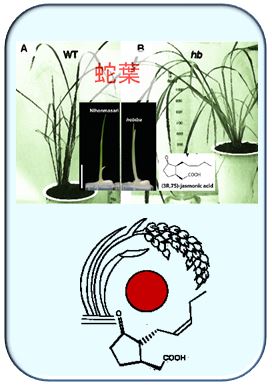Rice taking dark for light
Riemann M, Müller A, Korte A, Furuya M, Weiler EW, Nick P (2003) Impaired Induction of the Jasmonate Pathway in the Rice Mutant hebiba. Plant Physiol 133, 1820-1830 (82 quotations, state 27.09.2019 ) - pdf
What is it about? The coleoptile of rice grows fast in the dark and has the Task to guide the young leaves through the soil towards the light. In the very moment, when the tip of this juvenile organ meets the light, it stops growing. It is the photoreceptor phytochrome that conveys this light sensing of the coleoptile. "Blind" mutants of rice, lacking a functional phytochrome should continue coleoptile growth in the light. In a collection of mutants that had been generated by radioactive irradiation in the so called Gamma-Field North of Tokyo, we discovered in 1991 such a "blind" mutant. This mutant also displayed hypertrophic leaf growth and its creeping leaves coined the name of this mutant, hebiba (Japanese for "Snake Leaf"). A more detailed analysis demonstrated that this mutant is not blind at all. It is well able to see the light, but it takes it for darkness - in the dark coleoptile growth is blocked, whereas it is stimulated in the light (just opposite to the behaviour of the wildtype). When we searched for the cause of this curious phenotype, we found that this Mutant lacks the ability to produce the plant hormone jasmonic acid. Jasmonates were known already as stress hormones - from the hebiba mutant we learnt that jasmonates also participate in the processing of light signals.

